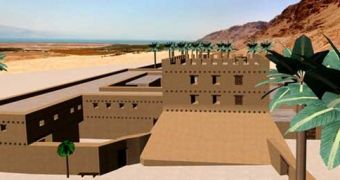What a sensation caused at that times the discovery of the Dead Sea Scrolls in Qumran caves (in today's West Bank) in 1947 by a shepherd boy!... These are the only ancient manuscripts older than 100 BC of the Hebrew Bible (Old Testament) preserved till today. In historical times, Qumran was a peaceful place of worship where the Essenes, a strict religious group, with a life style resembling that of a monk, settled there from Jerusalem somewhere between 130 and 100 BC and painstakingly copied the scrolls.
But a new research shows that fierce warriors once inhabited the famous complex of Qumran site. Based on the first ever virtual 3-D reconstruction of the site, historians recently discovered evidence of a fortress that was later turned into its monastery-like place.
"Once you put all the archaeological evidence into three dimensions, the solution literally jumps out at you," said lead researcher William Schniedewind, chair of Ancient Eastern Mediterranean Studies at UCLA.
This is how the researchers solved the mystery of the complicated 20,000 square foot (2,000 square meters) residential complex where the scrolls are thought to have been written. The defensive four-story tower doesn't look like the site of a monastery. Some areas were built as add-ons or renovations, like a communal dining hall.
"With the 3-D model, the UCLA researchers deconstructed the complex piece by piece. That allowed them to "see" architectural elements invisible to the naked eye. The various sizes of the walls and their ability to support weight (e.g., necessary for multi-story construction/fortification) was not immediately clear in the archaeological plan," said Schniedewind.
"Once we put the dining hall into the model, we realized it had to be an addition. It only fits to the south of the original structure." said co-author Bob Cargill, UCLA graduate student.
This means that communal living first had more militaristic goals.
"During its period as a fort, the first extended occupation of Qumran was probably by a band of mighty warriors called the Hasmoneans, whose victory over Greek occupiers is celebrated during Hanukkah," believe the UCLA historians.
Greeks had occupied Judea during the campaigns of Alexander the Great.
The scrolls could have been rushed from the Qumran location and hidden in the caves during a fight with Roman troops in 66 A.D.
"The site was chosen (by Essenes) because the wilderness was a place that people went to seek God--indeed, this was the reason that the Dead Sea Scrolls give for choosing a desert site for this settlement," Schniedewind told LiveScience.
Essene monks followed a very strict ritual life at the Qumran.
"The new findings support the theory that the building had at least a few occupants prior to the Essenes, among them-some historians have suggested-an aristocratic family from Jerusalem who used the building as a vacation home. It makes sense, given the limit of practical places to live in that part of the world. There are very few possible places that could be settled in the Judean desert. So, everyone who settles there tends to choose the same places. Specifically, there are very few viable water sources. The site of Qumran ... allowed the collection of runoff using dams, aqueducts and pools." said Schniedewind.

 14 DAY TRIAL //
14 DAY TRIAL //